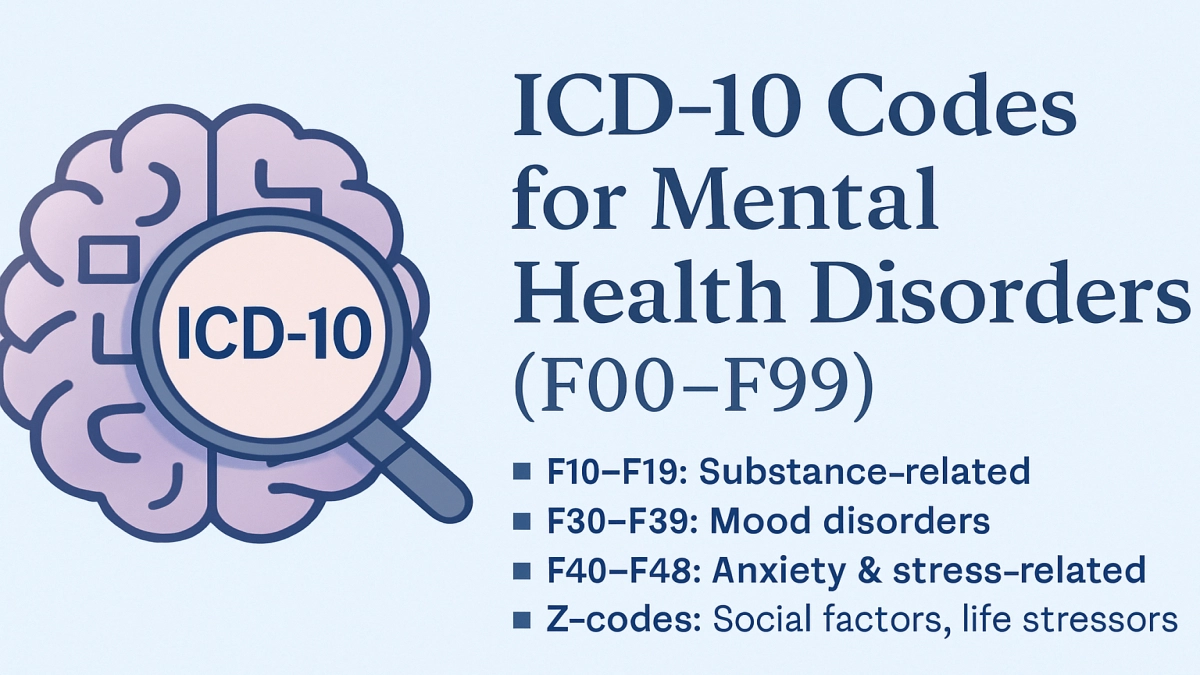The ICD-10 system isn’t just about codes—it’s the language of modern healthcare. And in the field of mental health, where diagnoses can be nuanced and overlapping, ICD 10 for mental health becomes even more essential. Whether you’re a clinician, a mental health biller, or simply someone trying to understand how this coding system works, this guide breaks it all down—clearly, comprehensively, and with insights you won’t find in every article.
What is ICD 10 and Why Does it Matter in Mental Health?
The International Classification of Diseases, 10th Revision (ICD-10), is a globally recognized coding system developed by the World Health Organization (WHO). It provides standardized codes for diseases, disorders, injuries, and health conditions—including mental and behavioral disorders.
For mental health, these codes are crucial in:
- Diagnostic documentation
- Insurance billing and reimbursements
- Statistical analysis and research
- Care coordination between providers
In short, without the correct ICD 10 mental health code, providers risk denied claims, miscommunication, or inaccurate treatment records.
Top ICD 10 Codes for Mental Health Professionals
Here’s a list of frequently used ICD-10 codes in psychiatric and behavioral health settings:
| Diagnosis | ICD-10 Code |
|---|---|
| Major depressive disorder, single episode | F32.0 – F32.9 |
| Generalized anxiety disorder | F41.1 |
| Bipolar disorder | F31.0 – F31.9 |
| PTSD (Post-Traumatic Stress Disorder) | F43.10 |
| Schizophrenia | F20.0 – F20.9 |
| Adjustment disorders | F43.20 – F43.29 |
| ADHD (Attention-Deficit/Hyperactivity Disorder) | F90.0 |
| Alcohol use disorder | F10.10 – F10.99 |
These are just a few of the hundreds of mental health codes within ICD-10. The level of specificity allows clinicians to track severity, frequency, and subtype, which is vital for both treatment and insurance compliance.
ICD 10 Mental Health Codes vs DSM-5: What’s the Difference?
Many practitioners ask:
“Why do we need ICD-10 when we already use the DSM-5?”
Here’s the breakdown:
| Aspect | ICD-10 | DSM-5 |
|---|---|---|
| Developer | WHO | American Psychiatric Association |
| Purpose | Global coding & billing | Clinical criteria & classification |
| Usage | Required for billing (US & global) | Used for diagnosis & assessment |
| Format | Alphanumeric codes (e.g., F32.1) | Descriptive criteria |
Best practice: Use DSM-5 for clinical diagnosis, then translate it into the corresponding ICD-10 code for documentation and billing.
Benefits of ICD 10 in Mental Health Care
- Improved documentation: Clear coding = better care continuity.
- Enhanced billing accuracy: Prevents denials and improves revenue cycles.
- Data-driven insights: Aggregated data helps in public health tracking.
- Global standardization: Enables consistent mental health care internationally.
Best Practices for Using ICD 10 in Mental Health Billing
Medical billers should follow these essential tips:
- Stay Specific: Use the most detailed code available (e.g., F32.2 instead of just F32).
- Pair with CPT Codes Properly: Diagnosis codes must match services rendered.
- Keep Updated: ICD-10 updates every October—codes change!
- Audit Proofing: Keep notes justifying the diagnosis, especially for complex psychiatric cases.
- Coordinate with Providers: Ensure therapists or psychiatrists are documenting symptoms that align with billable ICD-10 codes.
ICD 10 Mental Health Coding Training Programs
If you’re new to mental health billing or need a refresher, consider these reputable programs:
- AAPC’s Behavioral Health Coding Training
- AHIMA’s Mental Health ICD-10 Specialty Module
- Udemy and Coursera also offer affordable introductory ICD-10 courses
- State medical billing associations often host regional webinars and workshops
Tip: Add personal experience or reviews if you’ve tried any of these.
How Accurate Are ICD 10 Mental Health Codes?
ICD-10 mental health codes are as accurate as the clinical documentation behind them. They rely on the provider’s ability to:
- Perform a thorough diagnostic evaluation
- Align symptoms with DSM-5 criteria
- Choose the matching ICD-10 code
Coding errors often arise from vague diagnoses, outdated templates, or rushed charting. Cross-training staff on documentation and coding alignment can reduce costly mistakes.
ICD 10 vs ICD 9 for Mental Health: What’s Improved?
ICD-10 brought significant upgrades:
- More codes (from ~14,000 to 69,000+)
- Greater specificity
- Improved classification of psychiatric comorbidities
- Better compatibility with electronic health records (EHRs)
For mental health, this means less ambiguity and better care coordination.
How to Choose the Right ICD 10 Mental Health Code
- Review clinical documentation thoroughly.
- Use DSM-5 to establish diagnostic criteria.
- Search the ICD-10 index or encoder.
- Check for specificity (severity, episode type, etc.).
- Validate with payer policies, if applicable.
Guide to Understanding ICD 10 Mental Health Codes
ICD-10 uses the “F” category (F01–F99) for all mental and behavioral disorders. Each section includes:
- Main diagnosis category (e.g., F32 for depression)
- Subtypes and modifiers (e.g., F32.2 = severe without psychotic features)
- Exclusions, notes, and coding instructions
An internal linking opportunity here could be:
👉 “For a deeper dive into ICD-10 categories by specialty, check our [Complete Guide to ICD 10 Categories for Medical Billing].”
Alternatives to ICD 10 for Mental Health Diagnosis
While ICD-10 is the standard for billing, some other tools include:
- DSM-5 – gold standard for clinical diagnosis
- SNOMED CT – detailed terminology used in EHRs
- ICD-11 – slowly being adopted, more modern structure
- LOINC/HCPCS – used in specific billing/data exchange contexts

